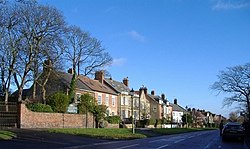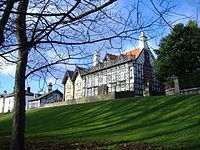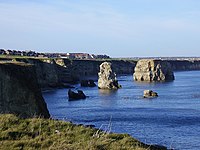Whitburn, County Durham
| Whitburn | |
| County Durham | |
|---|---|
 Whitburn | |
| Location | |
| Grid reference: | NZ409620 |
| Location: | 54°57’6"N, 1°21’47"W |
| Data | |
| Local Government | |
| Council: | South Tyneside |
Whitburn is a coastal village in County Durham. It lies just to the north of the City of Sunderland. The village has a population of 5,235.[1]
Name of the village
This Whitburn has a different origin from the one in West Lothian, which means "white burn (brook)": Durham's Whitburn comes from Old English also but from hwit bereærn, meaning "white barn". A record of the name as Wituberne in 1182 bears witness to this.
History
Whitburn is listed in the "Boldon buke" of 1183 as "Whitbern".
Following the attack of the Spanish Armada on England in 1588, the vanquished Spanish fleet fled around the coast of England. Two Spanish galleons ran aground on Whitburn Rocks in rough seas and local inhabitants plundered the wreckage. The bell from one of the galleons was placed in Whitburn Church. Spanish oak beams removed from the shipwrecks could still be viewed in the roof of the Whitburn lawnmower shop in the 1950s prior to the buildings demolition.
Whitburn remained fairly undisturbed settlement until 1718 when the local Enclosure Act came into force and a number of farms were created . The settlement was isolated as no roads connected to it, but there was a path on Sea Lane (now East Street) connecting it to Whitburn Bents, a nearby hamlet. Not until 1866 was a road built over the sandunes to Fulwell, in northern Sunderland. In 1874 Marsden Pit was sunk and the community increased dramatically as a result. Whitburn Colliery closed in 1968, and the land is now a coastal park and nature reserve[2].
The village and hereabouts
Whitburn has retained its village character, with its main street, parish church, cricket ground and park with bowling greens and tennis courts.
Between the town and the coast are rifle ranges, marked as a danger area inland of Souter Head, though this is no hindrance to enjoyment of the sea: the main hindrance is the plunging cliff. A coastal path follows the edge of the sea, and a little south of the village is a walk down to a sandy beach, at Whitburn Bay between Whitburn and the conurbated towns of Sunderland.
It is generally accepted that Lewis Carroll wrote The Walrus and the Carpenter while holidaying at his cousins' house in Whitburn[3]. A statue of Carroll is in the library[4].
Whitburn Windmill is a Grade II listed building, as it is considered to be of special architectural and historical importance. In 1960 it was acquired from the Church Commissioners by the municipal authorities and in 1991/1992 the council undertook a restoration project of the mill, including restoration of the sails, for which it was awarded the Civic Trust Award.
To the north of the village, near Marsden Village, is Whitburn Coastal Park, near which is cared for by the National Trust team based at the Souter Lighthouse. This recreation area is a popular haunt for birdwatchers. A sea-watching observatory is used mainly by Durham Bird Club members, who monitor seabird and wildfowl migration throughout the year (activity peaks during July-November), but is open to all bird-watchers. Keys (£12) can be bought at the National Trust shop at Souter Lighthouse but the observatory is normally in use whenever seabird and wildfowl passage is in progress which means it can be accessed by bird-watchers without keys. Whitburn is one of the premier sites on the east coast of England for seawatching with notable list of rarities to its name. A good variety of cetaceans are also seen from here, particularly in late summer.
There are three public houses in Whitburn. The Grey Horse on North Guards, The Jolly Sailor on Front Street and the Whitburn Lodge on the Coast Road which used to be part of the former Whitburn Colliery buildings.
References
Outside links
- Whitburn Community Website
- History of Mining at Whitburn from the Durham Mining Museum
- Photographs of Whitburn, old and new from the Whitburn Local History Group

